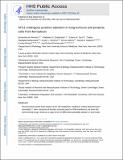| dc.contributor.author | Alvarez, Samantha W. | |
| dc.contributor.author | Sviderskiy, Vladislav O. | |
| dc.contributor.author | Terzi, Erdem M. | |
| dc.contributor.author | Papagiannakopoulos, Thales | |
| dc.contributor.author | Moreira, Andre L. | |
| dc.contributor.author | Adams, Sylvia | |
| dc.contributor.author | Birsoy, Kıvanç | |
| dc.contributor.author | Sabatini, David | |
| dc.contributor.author | Possemato, Richard | |
| dc.date.accessioned | 2018-07-03T18:14:37Z | |
| dc.date.available | 2018-07-03T18:14:37Z | |
| dc.date.issued | 2017-11 | |
| dc.date.submitted | 2016-05 | |
| dc.identifier.issn | 0028-0836 | |
| dc.identifier.issn | 1476-4687 | |
| dc.identifier.uri | http://hdl.handle.net/1721.1/116767 | |
| dc.description.abstract | Environmental nutrient levels impact cancer cell metabolism, resulting in context-dependent gene essentiality. Here, using loss-of-function screening based on RNA interference, we show that environmental oxygen levels are a major driver of differential essentiality between in vitro model systems and in vivo tumours. Above the 3-8% oxygen concentration typical of most tissues, we find that cancer cells depend on high levels of the iron-sulfur cluster biosynthetic enzyme NFS1. Mammary or subcutaneous tumours grow despite suppression of NFS1, whereas metastatic or primary lung tumours do not. Consistent with a role in surviving the high oxygen environment of incipient lung tumours, NFS1 lies in a region of genomic amplification present in lung adenocarcinoma and is most highly expressed in well-differentiated adenocarcinomas. NFS1 activity is particularly important for maintaining the iron-sulfur co-factors present in multiple cell-essential proteins upon exposure to oxygen compared to other forms of oxidative damage. Furthermore, insufficient iron-sulfur cluster maintenance robustly activates the iron-starvation response and, in combination with inhibition of glutathione biosynthesis, triggers ferroptosis, a non-apoptotic form of cell death. Suppression of NFS1 cooperates with inhibition of cysteine transport to trigger ferroptosis in vitro and slow tumour growth. Therefore, lung adenocarcinomas select for expression of a pathway that confers resistance to high oxygen tension and protects cells from undergoing ferroptosis in response to oxidative damage. | en_US |
| dc.publisher | Nature Publishing Group | en_US |
| dc.relation.isversionof | http://dx.doi.org/10.1038/NATURE24637 | en_US |
| dc.rights | Article is made available in accordance with the publisher's policy and may be subject to US copyright law. Please refer to the publisher's site for terms of use. | en_US |
| dc.source | PMC | en_US |
| dc.title | NFS1 undergoes positive selection in lung tumours and protects cells from ferroptosis | en_US |
| dc.type | Article | en_US |
| dc.identifier.citation | Alvarez, Samantha W. et al. “NFS1 Undergoes Positive Selection in Lung Tumours and Protects Cells from Ferroptosis.” Nature (November 2017) © 2017 Macmillan Publishers Limited, part of Springer Nature | en_US |
| dc.contributor.department | Massachusetts Institute of Technology. Department of Biology | en_US |
| dc.contributor.department | Koch Institute for Integrative Cancer Research at MIT | en_US |
| dc.contributor.mitauthor | Sabatini, David | |
| dc.contributor.mitauthor | Possemato, Richard | |
| dc.relation.journal | Nature | en_US |
| dc.eprint.version | Author's final manuscript | en_US |
| dc.type.uri | http://purl.org/eprint/type/JournalArticle | en_US |
| eprint.status | http://purl.org/eprint/status/PeerReviewed | en_US |
| dc.date.updated | 2018-07-03T17:48:59Z | |
| dspace.orderedauthors | Alvarez, Samantha W.; Sviderskiy, Vladislav O.; Terzi, Erdem M.; Papagiannakopoulos, Thales; Moreira, Andre L.; Adams, Sylvia; Sabatini, David M.; Birsoy, Kıvanç; Possemato, Richard | en_US |
| dspace.embargo.terms | N | en_US |
| dc.identifier.orcid | https://orcid.org/0000-0002-1446-7256 | |
| dc.identifier.orcid | https://orcid.org/0000-0002-2401-0030 | |
| mit.license | PUBLISHER_POLICY | en_US |
